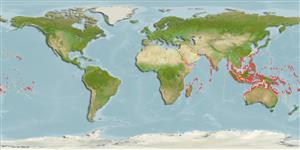分類 / Names
共通名の | 類義語 | Catalog of Fishes(部類, 種) | ITIS | CoL | WoRMS | Cloffa
Environment: milieu / climate zone / depth range / distribution range
生態学
海; 汽水性の 関連する礁; 深さの範囲 1 - 30 m (Ref. 1602). Tropical; 30°N - 28°S, 32°E - 139°W
Indo-Pacific: East Africa to the Tuamoto and Austral islands, north to the Ryukyu Islands, south to New Caledonia.
Length at first maturity / サイズ / 重さ / 年齢
Maturity: Lm ?, range 26 - ? cm
Max length : 45.0 cm TL オス/雌雄の選別がない; (Ref. 9710)
背面の脊椎 (合計) : 9; 背鰭 (合計) : 10; 肛門の骨: 3; 臀鰭: 8. This species is distinguished by the following characters: body moderately deep, its depth 2.3-2.6 times in standard length; dorsal profile of head convex; anterior tip of snout forming an acute angle; jaws prominent, 2 strong canines situated anteriorly in each jaw; no enlarged tooth present of rear of upper jaw. D IX,10, the spines and anterior soft rays of similar length; A III,8; pectoral fins with ii unbranched and 10 branched rays; pelvic fins long, reaching anus in small fish, well beyond in adults; centre of caudal fin rounded in adults, with the upper and lower rays forming elongate lobes giving the fin a trilobed appearance; lateral line interrupted below posterior portion of dorsal-fin base, with a total of 22-23 pored scales; scales reaching well onto bases of dorsal and anal fins; scales in front of dorsal fin extending forward to above centre of eye; cheek and opercle scaly; lower jaw without scales. Colour of the body variably pigmented from green to brown with mottled purple and red markings; 4 vertical dark bars on body that are often indistinct on large individuals; head with numerous small red spots; red lines radiating from anterior and posterior of eye; scales on sides each with a vertical, slightly curved red line; dorsal, anal, and pectoral fins yellow or green with distal red streaks; caudal fin green with a red posterior margin; juveniles with 3-4 dark spots midlaterally on sides and more prominent dark bars. This species capable of rapid colour changes (Ref. 9823).
Adults inhabit lagoon and seaward reefs at depths of 1 to over 30 m, and relatively common along shallow reef margins with good coral cover (Ref. 9710). Usually solitary (Ref. 5213). Feed mainly on shelled benthic invertebrates such as mollusks and crustaceans, but occasionally take fishes (Ref. 1602). Oviparous, distinct pairing during breeding (Ref. 205). Difficult to approach (Ref. 9710). Juveniles secretive on algae reefs and usually around stinging hydrozoans (Ref. 48636).
Life cycle and mating behavior
成熟 | 繁殖 | 放精 | 卵 | 生産力 | 幼生
Oviparous, distinct pairing during breeding (Ref. 205).
Westneat, M.W., 2001. Labridae. Wrasses, hogfishes, razorfishes, corises, tuskfishes. p. 3381-3467. In K.E. Carpenter and V. Niem (eds.) FAO species identification guide for fishery purposes. The living marine resources of the Western Central Pacific. Vol. 6. Bony fishes part 4 (Labridae to Latimeriidae), estuarine crocodiles. FAO, Rome. (Ref. 9823)
IUCNのレッドリストの状況は (Ref. 130435: Version 2024-1)
Human uses
水産業: 少数商業の; 水族館・水槽: 商業
用具
特記事項
XMLをダウンロードして下さい
インターネットの情報源
Estimates based on models
Preferred temperature (Ref.
123201): 25.2 - 29.3, mean 28.4 °C (based on 3095 cells).
Phylogenetic diversity index (Ref.
82804): PD
50 = 0.5078 [Uniqueness, from 0.5 = low to 2.0 = high].
Bayesian length-weight: a=0.02239 (0.01571 - 0.03191), b=2.95 (2.85 - 3.05), in cm total length, based on LWR estimates for this species (Ref.
93245).
栄養段階 (Ref.
69278): 3.9 ±0.2 se; based on diet studies.
回復力 (Ref.
120179): 手段, 1.4年~4.4年の倍増期間の最小個体群 (Preliminary K or Fecundity.).
Fishing Vulnerability (Ref.
59153): Low to moderate vulnerability (35 of 100).
Nutrients (Ref.
124155): Calcium = 35.7 [18.4, 61.7] mg/100g; Iron = 0.581 [0.245, 1.126] mg/100g; Protein = 17.8 [13.6, 21.1] %; Omega3 = 0.0833 [, ] g/100g; Selenium = 30.6 [15.1, 62.7] μg/100g; VitaminA = 137 [21, 863] μg/100g; Zinc = 2.5 [1.4, 3.5] mg/100g (wet weight); based on
nutrient studies.
